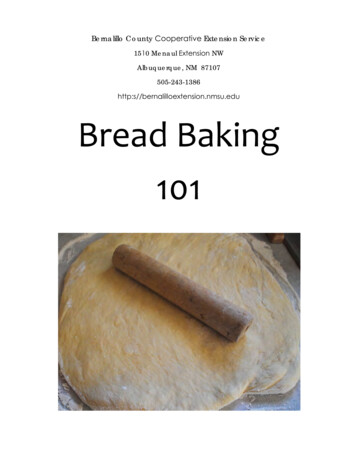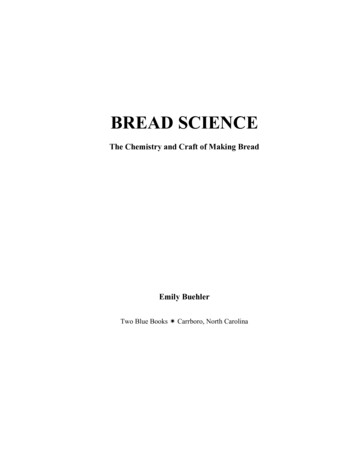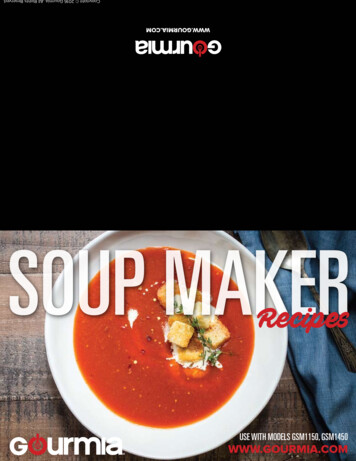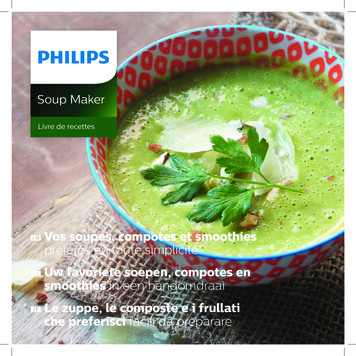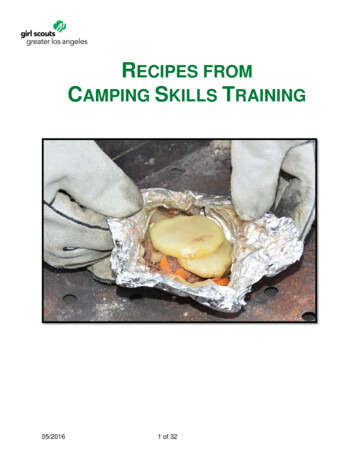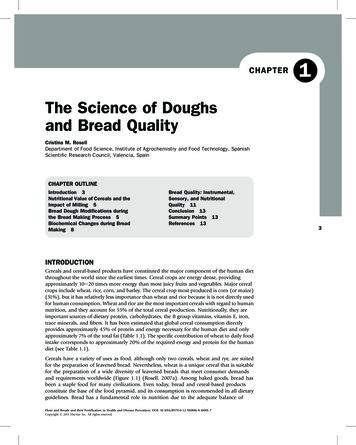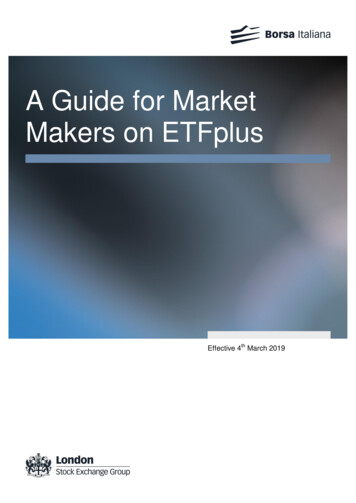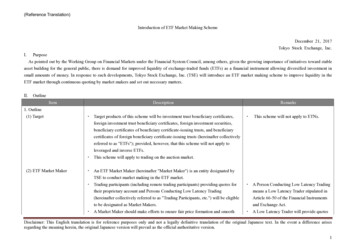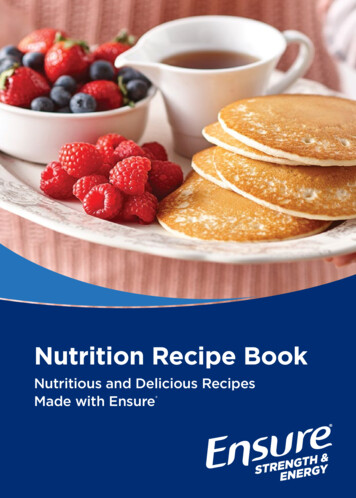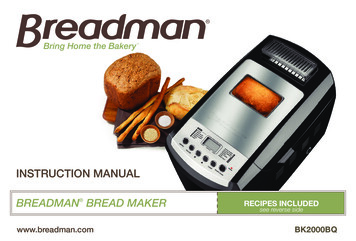
Transcription
Bring Home the BakeryTMINSTRUCTION MANUALBREADMAN BREAD MAKERwww.breadman.comRECIPES INCLUDEDsee reverse sideBK2000BQ
Please Read and Save this Use and Care BookIMPORTANT SAFEGUARDSWhen using electrical appliances, basic safety precautionsshould always be followed including the following: Read all instructions. Do not touch hot surfaces. Use handles or knobs. To protect against electrical shock do not immerse cord,plugs, or appliance in water or other liquid. Close supervision is necessary when any appliance is usedby or near children. Unplug from outlet when not in use and before cleaning.Allow to cool before putting on or taking off parts. Do not operate any appliance with a damaged cord or plug,or after the appliance malfunctions or has been damaged inany manner. Contact Consumer Services for examination,repair or electrical or mechanical adjustment. Or, call theappropriate toll-free number on the cover of this manual. The use of accessory attachments not recommended by theappliance manufacturer may cause fire, electric shock orinjury. Do not use outdoors. Do not let cord hang over edge of table or counter, or touchhot surfaces, including the stove. Do not place on or near a hot gas or electric burner, or in aheated oven. 2 E xtreme caution must be used when moving an appliancecontaining hot oil or other hot liquids.To disconnect, press and hold the STOP button for severalseconds, remove plug from wall outlet.Do not use appliance for other than intended use.Avoid contacting moving parts. SAVE THESE INSTRUCTIONSThis product is for household use only.Care arts(USA / Canada)1-800-738-0245For online customer serviceand to register your product, go towww.prodprotect.com/applica
Caution, hot surfaces: This appliancegenerates heat and escaping steamduring use. Proper precautionsmust be taken to prevent the riskof burns, fires or other injury topersons or damage to property.POLARIZED PLUG (120V Models Only)This appliance has a polarized plug (one blade is wider thanthe other). To reduce the risk of electric shock, this plug isintended to fit into a polarized outlet only one way. If the plugdoes not fit fully into the outlet, reverse the plug. If it still doesnot fit, contact a qualified electrician. Do not attempt to modifythe plug in any way.TAMPER-RESISTANT SCREWWarning: This appliance is equipped with a tamper-resistantscrew to prevent removal of the outer cover. To reduce therisk of fire or electric shock, do not attempt to remove theouter cover. There are no user-serviceable parts inside.Repair should be done only by authorized service personnel.ELECTRICAL CORDa) A short power-supply cord (or detachable power-supplycord) is to be provided to reduce the risk resulting frombecoming entangled in or tripping over a longer cord.b) Longer detachable power-supply cords or extensioncords are available and may be used if care is exercisedin their use.c) If a long detachable power-supply cord or extensioncord is used,1) The marked electrical rating of the detachablepower-supply cord or extension cord should beat least as great as the electrical rating of theappliance,2) If the appliance is of the grounded type, theextension cord should be a grounding-type3-wire cord, and3) The longer cord should be arranged so that it willnot drape over the countertop or tabletop where itcan be pulled on by children or tripped over.Note: If the power supply cord is damaged, it should bereplaced by qualified personnel; in Latin America, by anauthorized service center.3
POWER OUTAGE7-Minute Power Failure Back-UpYour Breadman Bread Maker has a 7-minute power failureback-up feature. If the electricity goes out, the memory willstore your cycle selection for up to 7 minutes. If the powercomes back on within this time, bread making will resumewhere it left off.If the bread maker loses power for more than 7 minutes andyou are using any dairy products, perishables or meat in yourbread, you should discard the contents of the recipe and startagain with new fresh ingredients due to health and sanitaryconsiderations. For nonperishable recipes you may try startingthe bread maker at the beginning of the cycle again. However,this may not always produce an acceptable loaf of bread.If you are not sure when the outage occurred, remove the doughand discard.4Product may vary slightly from what is illustrated.† 1. Removable lid (Part # BK2000BQ-01)2. Lid handle3. Cord wrap (not shown)4. Viewing window5. Automatic fruit & nut dispenser6. Control panel7. Baking chamber† 8. Traditional bread pan (Part # BK2000BQ-02)† 9. 1-lb. bread pans (2) (Part # BK2000BQ-03)† 10. C ollapsible kneading paddles fortraditional bread pan (2) (Part #BK2000BQ-04)† 11. N on-collapsible kneading paddlesfor 1-lb. bread pans (2) (Part #BK2000BQ-05)† 12. Measuring cup (Part #BK2000BQ-06)† 13. Measuring spoon (Part #BK2000BQ-07)† 14. K neading paddleremoval key (Part # (Part #BK2000BQ-08)Note: † indicates consumerreplaceable/removable parts
2148659711101213145
CONTROL PANEL1. POWER LIGHTIlluminates when START button is pressed.2. DISPLAY WINDOWShows selection and timer setting.DISPLAYWINDOW3. MENU BUTTONSelects cycle. Each time the MENU button ispressed, the number for the cycle selected andthe program time will appear in the displaywindow.4. START/STOP BUTTONPress and hold for several seconds to cleardisplay, reset cycle or to simply stop baking.5. AND BUTTONSUse this pair of buttons to adjust the bakeonly time and to set delay bake timer; add orsubtract time displayed in the display window. Increases in 10-minute intervals. Decreases time in 10-minute intervals.6
6. LOAF BUTTONSelects loaf size: 1½-lb., 2-lb. or 2½-lb.Loaf size is preset to 2½-lb.Rapid loaf is preset to 2-lb. Note: For two, 1-lb. loaves, see section“BAKING ONE POUND LOAVES”.7. COLOR BUTTONSelects crust color: light, medium or dark.Crust color is preset to medium.Note: When using Rapid bake, your crust color will be setto medium. Note: When you press the buttons, you should hear a beep.This will let you know you’ve pressed hard enough to makeyour selection.KNEADING AND BAKING CYCLESNote: If at any time during bread making process you need toturn bread maker off, press and hold the START/STOP buttonfor several seconds, then unplug the unit.Note: If bread is not removed immediately after baking andSTART/STOP button is not pressed, a controlled 60-minuteKeep Warm mode will begin (except during Quick Bread,Dough and Jam). For best results, remove bread immediatelyafter baking process is complete.WHITEUsed for breads that primarily include white bread flour,although some recipes may include small amounts of wholewheat flour.WHOLE WHEATUsed for recipes with significant amounts of whole wheat orrye flour, oats or bran. Whole wheat cycle begins with restperiod during which flours or grains absorb liquid ingredients.Soaking causes flour or grain to soften and helps ingredientsto combine. Generally, whole wheat and multi-grain breads areshorter and denser than white, French or sweet.FRENCHTraditionally, French bread has a slightly crispier crust andlighter texture than white bread. Recipes usually do not includebutter, margarine or milk.7
SWEETUsed for recipes that contain eggs, fruit juice, additional sugaror added sweet ingredients such as coconut flakes, raisins,dried fruit or chocolate. Baking temperature is reduced toprevent burning.GLUTEN-FREEUsed for gluten-free recipes.QUICK BREADUsed for recipes that contain baking powder or baking soda,rather than yeast, to make bread rise. Cake recipes made fromscratch must be specially designed for this cycle.DOUGHUse to prepare dough for making bread, rolls or pizza whichare shaped and allowed to rise before baking in a conventionaloven. This program blends and kneads the dough and takes itthrough the first rise.8LOW CARBUsed for recipes that are lower in carbohydrates.JAMUse to prepare preserves, marmalade, chutneys and ketchup.Add fruit, sugar and lemon juice for homemade preserves –a great topping for homemade bread, waffles and ice cream.RAPIDUsed for White, Whole Wheat and Sweet cycles to decreasetime to approximately 1 hour. Choose recipe, then simply add½ tsp. to amount of yeast listed for a 2-lb. loaf. Bread may beshorter and denser than bread made using the longer program.BAKE ONLYUsed if crust is too light or you wish to bake pre-madedough – also especially useful if your bread is not quite done.Check every few minutes. Bakes for up to 1 hour, 30 minutes.
KNOW YOUR INGREDIENTSFLOUR & OTHER GRAINSALL-PURPOSE FLOURAll-purpose flour is a blend of refined hard and soft wheat flours ideally suited for making quickbreads and cakes.BRANBran (unprocessed) is coarse outer portion of wheat or rye grains that is separated from flourby sifting or bolting. It is often added to bread in small quantities for nutritional enrichment,heartiness and flavor. It is also used to enhance bread texture.BREAD FLOURBread flour typically has higher gluten concentration than all-purpose flour. Using bread flourwill produce loaves with better volume and structure.CORNMEAL AND OATMEALCornmeal and oatmeal come from coarsely ground white or yellow corn and from rolled orsteel-cut oats. They are used primarily to enhance flavor and texture of bread.CRACKED WHEATCracked wheat has very coarse texture. It comes from wheat kernels cut into angularfragments. It gives whole grain breads a nutty flavor and crunchy texture.RYE FLOURRye flour must always be mixed with high proportion of bread flour, as it does not containenough gluten to develop structure for high, even-grained loaf.SELF-RISING FLOURSelf-Rising Flour is NOT RECOMMENDED for use with your bread maker. Self-rising flourcontains leavening ingredients that will interfere with bread and quick bread making.7 GRAIN CEREAL BLEND7 grain cereal blend is a blend of cracked wheat, oats, bran, rye, cornmeal, flax seeds andhulled millet. It is used primarily to enhance flavor and texture of bread.VITAL WHEAT GLUTENVital Wheat Gluten is manufactured from wheat flour that has been treated to remove nearlyall of the starch to leave a very high protein content. (Gluten is the protein in wheat that makesdough elastic.) Vital Wheat Gluten is available at most health food stores. It can be used insmall portions to increase volume and lighten texture.WHOLE WHEAT FLOURWhole wheat flour is milled from the entire wheat kernel, which contains the bran and germ.This high fiber flour is richer in nutrients than all-purpose or bread flour. Breads made withthis flour are usually smaller and heavier than white loaves. Many recipes mix whole wheatflour with bread flour or vital wheat gluten to produce higher, lighter-textured bread.9
TIPS ON FLOUR STORAGEKeep flour in a secure, airtight container. Store rye and wholewheat flours in a refrigerator, freeze or a cool area to preventthem from becoming rancid. Allow flour to come to roomtemperature before using.Note: Flours, while visibly similar, can be very different in howthey are ground, milled, stored, etc. You may have to experimentwith different brands of flour to help you make the perfect loaf.See RECIPE TIPS to assist with these experiments.YEASTActive yeast, through a fermentation process, produces carbondioxide gas necessary to make bread rise. Yeast feeds oncarbohydrates in sugar and flour to produce this gas. Threedifferent types of yeast are available: fresh (cake), active dry andquick-acting. Quick, rapid rise and bread machine yeasts arequick-acting. Fresh (cake) yeast is NOT RECOMMENDED foruse with your bread maker.TIPS ON YEASTEnsure your yeast is fresh by checking its expiration date.Ideally, yeast should be used several months before theexpiration date. Once a package or jar of yeast is opened, it isimportant that the remaining contents be immediately resealedand refrigerated or frozen for future use. Often dough that failsto rise is due to stale yeast.10Note: Basic bread and dough recipes in this booklet weredeveloped using active dry yeast. You may use chart below tosubstitute any quick-acting yeast (quick rise, fast rise or breadmaker yeast) for active dry yeast.CONVERSION CHART FOR BREAD MACHINE YEAST¾ tsp. bread machine yeast ½ tsp. quick-acting yeast1 tsp. bread machine yeast ¾ tsp. quick-acting yeast1½ tsp. bread machine yeast 1 tsp. quick-acting yeast2¼ tsp. bread machine yeast 1½ tsp. quick-acting yeast1 tbsp. bread machine yeast 2 tsp. quick-acting yeastRAPID CYCLESRapid cycle settings for White, Whole Wheat and Sweetdecrease time for making your favorite bread in approximately1 hour. Choose recipe, then add an additional ½ tsp. of breadmachine yeast to the recipe. The bread may be shorterand denser.
ADDITIONAL INGREDIENT NOTESImportant: Exact measurements for ingredients are the most important part of baking. It is the key to getting great textureand consistency in your bread. Make sure to measure all ingredients exactly.BAKING POWDERDouble-acting baking powder is a leavening agent used in quick breads and cakes. This type of leaveningagent does not require rising time before baking, as chemical reaction works when liquid ingredientsare added and again during baking process.BAKING SODABaking soda is another leavening agent, not to be confused or substituted for baking powder.It also does not require rising time before baking, as chemical reaction works during baking process.EGGSEggs add richness and velvety texture to bread dough and cakes. When recipe calls for egg(s),large egg(s) at room temperature should be used.FATSButter, margarine and oil shorten or tenderize the texture of yeast breads. French bread gets uniquecrust and texture from the lack of added fat. However, breads that call for fat stay fresh longer.If butter is used directly from refrigerator, it should be cut into small pieces for easier blendingduring kneading process.LIQUIDSAll liquids should be warm 80ºF/27ºC to 90 F/32 C for all recipes. Liquids, such as milk, water or acombination of powdered milk and water, can be used when making bread. Milk will improve flavor,provide velvety texture and soften the crust, while water alone will produce a crispier crust. Vegetableor fruit juices and potato water may be used for flavor variety.SALTSalt is necessary to balance flavor in breads and cakes; it also limits growth of yeast. Changing theamount of salt in a given recipe may result in shorter, gummier bread. When first making a type ofbread, do not increase or decrease amount of salt shown in the recipe.SUGARSugar is important for color and flavor of breads. It also serves as food for yeast since it the supportsfermentation process. Recipes in this book that call for sugar require granulated sugar.Important: Do not substitute powdered sugar. Artificial sweeteners cannot be used as substitute,as yeast will not react properly with them.11
CLIMATE CHANGES & BAKING In high-altitude areas (over 3,000 feet) dough tends to risefaster, as there is less air pressure. Therefore, less yeast isnecessary. In dry climates, flour is drier and requires slightly moreliquid. In humid climates, flour is wetter and will absorb less liquid,so less liquid is required.HOW TO USETHIS PRODUCT IS FOR HOUSEHOLD USE ONLY.GETTING STARTED Remove packing materials and any stickers. Please go to www.prodprotect.com/applica to register yourwarranty. Place bread maker on dry, stable, level surface away fromheat and areas where cooking grease or water may splatteron unit. Do not place near edge of countertop. If placingbeneath cabinets, make sure there is enough room to openthe lid without interference.12Important: Your bread maker will bake up at 2½-lb. loaf.Do not put larger quantities of ingredients into bread pan.Bread will not mix and bake correctly and bread maker maybe damaged. (See MAXIMUM INGREDIENT AMOUNTS.) Before first use, operate on Rapid White cycle withoutadding ingredients to burn off manufacturing oils. (Followinstructions in USING YOUR BREAD MAKER.) Note: During first use, bread maker may smoke and/oremit an odor from mineral oils used in manufacturing. Thisis normal.MAXIMUM INGREDIENT AMOUNTS Bread cycles: approximately 5 cups Quick breads: 4 cups Dough cycle: 4 2/3 cups Jam: 3 cups of fruit mixture
BREAD PAN TIPSInserting bread panNote: Remember to insert kneading paddles first, then add allingredients in the order listed BEFORE inserting the bread paninto baking chamber.Important: Collapsible kneading paddles may fall wheningredients are added. This is normal. They will stand upwhen kneading begins. When inserting bread pan into bread maker, make sure toset firmly in place.Removing bread pan To remove bread pan from baking chamber, hold handle withan oven mitt and lift straight up.Important: When you remove bread pan after baking, be sureto wear oven mitts to prevent burning. After removing loaf (by turning bread pan upside downand shaking gently), check to see that kneading paddle isremoved from loaf. If it is stuck in bread, allow bread to cool;then use the paddle removal key to remove it, taking care notto scratch the kneading paddles. Allow bread to cool beforeremoving the kneading paddles.CHECKING DOUGH CONSISTENCYAlthough your bread maker will mix, knead and bakebread automatically, when baking bread from scratch, it isrecommended that you learn to recognize condition of yourdough. The ratio of flour to liquid is the most critical factor inany bread recipe, yet the most easily remedied. After 5 to 8minutes in Knead 2, open bread maker to check consistencyof dough. Dough should be in a soft, tacky ball (feel sticky likescotch tape). If it is too dry, add 1 tsp. of liquid at a time. If it istoo wet, add 1 tbsp. of flour at a time.13
USING YOUR BREAD MAKERNote: D epending on the cycle or recipe used, some steps maynot apply or there may be additional steps. Refer to therespective recipes instructions in the recipes portionof this book, as well as the specific cycle instructionslocated at the end of these usage instructions.1. Open lid and remove bread pan. Liftbread pan straight up and out usingthe handle (B).Caution: Do not turn or shake breadpan while taking it out. If the bread panis bent, temperature sensor maynot work properly.B2. Position kneading paddle on thedrive shaft. Match flat side of driveshaft to flat part of hole in kneadingpaddle (C).Make sure paddle is secure.3. Place ingredients into the bread pan.Note: A s you add ingredients intothe bread pan, the collapsibleCkneading paddles may fall; thisis normal. Paddles will stand upautomatically once the cycle is started.Important: Add ingredients to bread pan in the order listed inthe recipe.Important: Always add yeast last.144. Make small indentation on top of dryYeastingredients (not so deep it reachesthe wet layer) and add yeast (D).Important: Indentation for yeast isDryimportant, especially when usingthe delay bake timer. It keeps yeastLiquidaway from the wet ingredients untilDthe kneading process begins. (Liquidingredients will prematurely activatethe yeast.)5. Insert the bread pan into the bakingchamber (E). Press down on rim ofbread pan until it snaps securely intoplace.6. Close the lid. If your recipe includesEextra ingredients such as fruits ornuts (listed after the yeast in therecipe), add these to the automatic fruit and dispenser.Important: Do not exceed 2/3 cup capacity.Important: Do not pour liquids or spices into dispenser.Always make sure fresh fruit or vegetables are not wet;pat dry before putting them in the dispenser.7. Plug into standard electrical outlet. Bread maker will beepand program 1 and 3:25 will appear in the display window.
8. Press MENU to choose desired cycle (F1). The POWER lightwill illuminate. Each time MENU is pressed, unit and displaywill move to the next cycle.Note: As the MENU button is pressed, the Rapid cycle settingwill follow the regular cycle setting for White, Whole Wheatand Sweet.9. Press CRUST to choose crust color (F2). Bread maker ispreset for medium crust.Note: CRUST will not be activated for the following cycles: Jam Dough Bake Only RapidF10. Press LOAF to select loaf size (F3). Bread maker is presetto 2½ lb.Note: Loaf size cannot be activated for the following cycles: Jam Dough Rapid Gluten Free Low Carb11. Press START to begin kneading cycle (F4). The POWER lightwill illuminate. The time remaining will begin to count downin display window. Bread making time, program numberand color will be shown in display window.Note: During kneading cycle, yeast will activate and viewingwindow may begin to fog. (This will clear eventually so you canview the progress.)12. When your bread is finished baking,bread maker will beep and“3:25” will appear in displaywindow. Press START/ STOPand open lid. Using oven mitts,remove bread pan (G).Important: Remember, bread panGand loaf are both very hot! Be carefulnot to place either on tablecloth, plastic surface or otherheat-sensitive surface that may scorch or melt.15
Note: If bread is not removed immediately after baking andSTART/ STOP is not pressed, the Keep Warm mode willbegin. Bread maker will automatically turn off after60 minutes. For best results, remove bread immediatelyafter baking.Note: Keep Warm does not apply to the following cycles: Jam Dough Bake Only13. Turn bread pan upside down andshake to release bread (H). Placebread upright on wire rack to cool atleast 20 minutes before slicing.Note: T he collapsible kneading paddlesare designed to stay in the breadpan instead of sticking in yourHbread. Check to see if the paddlesstayed in the pan. If not, follow thecaution statements below when removing.Caution: Be sure to remove kneading paddle from thebread before serving.Caution: Bread pan, kneading paddle and bread will be veryhot. Allow bread to cool before removing the paddle andalways use the paddle removal key.14. Unplug unit and allow to cool completely before cleaning.(See CARE AND CLEANING INSTRUCTIONS.)16Important: Make sure to clean the inside of the bakingchamber thoroughly after each use.15. Once bread has cooled (approximately 2 hours) store in anairtight container.BAKING ONE POUND LOAVESImportant: You can bake either one or two breads at a time,as desired. The recipe book contains recipes for White, WholeWheat , French, Sweet, Low Carb and Gluten Free 1-lb. loaves(see 1-lb. loaves recipe section at the back of the recipe book).1. Open lid and remove traditional bread pan(if stored in appliance.)Caution: Do not turn or shake bread pan while taking it out.If the bread pan is bent, temperature sensor may not workproperly.2. Insert one of the two non-collapsible kneading paddles (donot use collapsible paddles) into each of the 1-lb. breadpans. Position kneading paddle on the drive shaft. Matchflat side of drive shaft to flat part of hole in kneading paddle.Make sure paddle is secure.3. Follow steps 3 and 4 in USING YOUR BREAD MAKER to addingredients.4. Insert one bread pan over each drive coupling in the bakingchamber and press down on rim of bread pan until it snapssecurely in place.5. Follow steps 5 through 9 in USING YOUR BREAD MAKER tobegin setting programming.
6. For LOAF size, press the and buttons simultaneouslyand hold; unit will beep and display will indicate loaf sizeof (2) 1.0 lbs.7. Press START to begin kneading cycle. The POWER light willilluminate. The time remaining will begin to count down indisplay window. Bread time and loaf size will be shown indisplay window.8. If additional ingredients are listed after the yeast, suchas nuts and fruits, listen for the beep near the end of thekneading cycle, about 30 minutes into the program.Add those ingredients.Important: Do not use the automatic fruit and nut dispenserwith the 1-lb. bread pans.9. Follow directions from step 12 to 15 in USING YOUR BREADMAKER to finish baking.SLICING AND STORING BREADFor best results, place bread on wire rack and allow to cool atleast 20 minutes before slicing. Use electric knife or serratedknife for even slices.Store unused bread, tightly sealed (sealable plastic bags orplastic containers work well) at room temperature for up to3 days. For longer storage, (up to 1 month) place bread insealed container in freezer. Since homemade bread has nopreservatives, it tends to dry out and become stale faster.Leftover or slightly hardened bread may be cut into ½-inchor 1-inch cubes and used in recipes to make croutons, breadpudding or stuffing.USING 15-HOUR DELAY BAKE TIMERImportant: Delay baking does not activate JAM cycle. Do notuse delay bake timer if your recipe includes perishables, suchas, eggs, fresh milk, yogurtor other dairy products and meats, etc.To preset your bread maker, follow these steps:1. Add ingredients in the order listed as usual, taking care notto let yeast and liquid ingredients contact one another.Note: If your recipe contains salt, add it with the liquidingredients, taking care to keep it away from the yeast.2. Close bread maker lid and plug it in.3. Press MENU to choose cycle. Time needed for selected cycleappears in display window.4. Press to add time in 10-minute intervals. (Use tosubtract time.) Amount of time set is shown in displaywindow. To fast-forward time, continually press . To fast-reverse, continually press . For example, if it is 8:00 AM and you want bread ready at1:00 PM, press until the display reads 5:00 – meaningit will finish baking in 5 hours. This is the hour differencebetween 8:00 AM and 1:00 PM.Note: Actual baking times will not change.17
5. Press LOAF to choose loaf size, press CRUST to choose crustcolor, then press START to begin timer. The colon (:) in timedisplay begins to flash, letting you know timer is started.When your bread is finished baking, bread maker will beepand “0:00” will appear in display window. Press START/STOPand open lid.6. If you make an error after you’ve activated program and wantto start over, press and hold START/STOP for approximately5 seconds. Timer will clear and you can begin again.BAKE ONLYThe Bake Only cycle offers the flexibility to vary time. You canbake pre-made dough or dough purchased at the store usingthis cycle. You may also use this cycle if crust color is too lightor if your sweet bread is not quite done. Check everyfew minutes.1. Press the MENU button and move to cycle 13.2. Adjust the amount of time you need up to 90 minutes.3. Press START to begin baking.SPECIAL GLAZES FOR YEAST BREADSSelect one of the following special glazes to enhance yourbread. Melted Butter Crust: Brush melted butter over just-bakedbread for a softer, more tender crust. Milk Glaze: For a softer, shiny crust, brush just-baked breadwith milk or cream.18 Sweet Icing Glaze: Mix 1 cup sifted confectioner’s sugar with1 to 2 tablespoons of milk, water or fruit juice until smooth.Drizzle glaze over raisin or sweet bread when they arealmost cool.Note: I f desired, generously sprinkle with your choice of nuts orseeds after glazing.DOUGH CYCLETips for Best Results If using delay bake timer, make sure yeast is on top of flour,away from liquids.Important: Never allow dough to remain in bread maker aftercycle is complete; it may over rise and damage machine. Rising times for dough after it is shaped and placed inbaking pan will vary due to recipe, temperature and humiditylevel of your kitchen. Optimum temperature for rising is 80 –85 F. Rising is the most essential feature in bread making. Bread maker allows dough to have first rise or fermentationbefore dough is removed. Fermentation conditions gluten,(becoming pliable and elastic with a soft, smooth quality)develops flavor and leavens product. Sometimes a double rising is beneficial especially for wholegrain or 100% whole wheat bread. Let dough rise once inbread maker. Remove from bread maker, punch down, letrise again, punch down and let rest 10 minutes. Restingallows gluten to relax and makes handling easier. Shape as
desired and allow to rise until doubled in volume. If only1 rise is desired, remove from bread maker, let rest, shapeand rise as above. Baker’s Tip: Dough has doubled in volume when anindentation remains after tip of a finger is pressed lightlyand quickly into dough. If indentation springs back, coverand let rise a few more minutes and check again.SPECIAL TIPS FOR MAKING DOUGHImportant: For use only with the Dough Cycle Always allow optimum rising of shaped dough. Use pastry brush to apply glaze. Bake as directed in recipe.APPLY JUST BEFORE BAKINGEgg Yolk GlazeFor shiny golden crust, mix 1 slightly beaten egg or egg yolkwith 1 tbsp. water or milk.Egg White GlazeFor shiny, chewy crust, mix 1 slightly beaten egg white with1 tbsp. water.If desired, sprinkle chopped nuts or fruit and/or seedsafter glazing.Lightly FlouredSprinkle enough flour onto work area so dough can be handledwithout sticking.SHAPED ROLLSImportant: Once rolls are shaped, cover and let rise untildoubled before baking.Cloverleaf RollsShape into ½-inch balls. Place 3 balls in each greasedmuffin tin.Crisscross RollsShape into balls, setting 2 aside. Combine balls and roll intoa 1/8-inch thick square. Cut strips 1/8-inch wide and 2-incheslong. Brush top of roll with beaten egg. Place 1 strip across topof each ball. Repeat process, placing second strip in oppositedirection across top of each ball.Traditional RollsShape into balls. For “pull apart” rolls, place dough balls withsides touching in 8 or 9-inch round or square greased bakingpan. For “individual” rolls place dough balls 2 inches apart.19
Crescent RollsOn lightly floured board, roll dough to 12-inch circle. Spreadwith softened butter. Cut into 16 wedges beginning at widerend. Place rolls 2-inches apart on greased baking sheet withpoints underneath; curve rolls slightly. If desired, brush withmelted butter just before baking.RosettesOn lightly floured board, roll about 1½ oz. piece of dou
Used for recipes that contain eggs, fruit juice, additional sugar or added sweet ingredients such as coconut flakes, raisins, dried fruit or chocolate. Baking temperature is reduced to prevent burning. GLUTEN-FREE Used for gluten-free recipes. QUICK BREAD Used for recipes that contain bak

